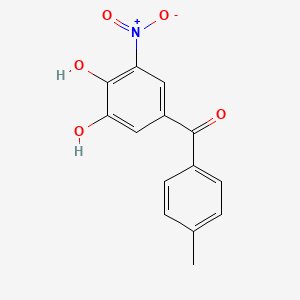Drug
D0121 | Tolcapone
N
N04BX01 Tolcapone
[N04BX] Other dopaminergic agents
[N04B] DOPAMINERGIC AGENTS
[N04] ANTI-PARKINSON DRUGS
[N] Nervous system
| Toxicity | Dose | Time | Species | Model | Method | Action | Positive criterion | Reference |
|---|---|---|---|---|---|---|---|---|
| UNCOUPLING | increase | 35 | ||||||
| ELECTROPHORETIC UNCOUPLING | 278 | |||||||
| ASSOCIATE WITH UNCOUPLING | rat | liver mitochondria | RST assay( Respiratory Screening Technology)-measurement of oxygen consumption in isolated mitochondria using a phosphorescent oxygen-sensitive probe A65N-1 | affect | 204 | |||
| MEMBRANE POTENTIAL | 3.9 µM | 30 mins | mouse | liver mitochondria | Rh123 fluorescence (excitation 485 nm, emission 535 nm) are recorded using a fluorescence multi-well plate reader (mCICCP (20 µM) treatments was considered as the 100% baseline for ΔΨm loss) | decrease | EC20 | 36 |
| RESPIRATION | ND | 60 mins | mouse | liver mitochondria | Oxygen consumption was monitored with 50nM MitoXpress ( an oxygen-sensitive phosphorescent dye) using a spectrofluorimeter (Tecan Infinite 200; λExcitation 380nm; λEmission 650nm). Rotenone (2µM) was used as 100% baseline for complex I inhibition. | Negative | EC20 | 36 |
| RESPIRATION | ND | 60 mins | mouse | liver mitochondria | Oxygen consumption was monitored with 50nM MitoXpress ( an oxygen-sensitive phosphorescent dye) using a spectrofluorimeter (Tecan Infinite 200; λExcitation 380nm; λEmission 650nm). Oligomycin A (1µM) was used as 100% baseline for complex II inhibition. | Negative | EC20 | 36 |
| OXYGEN CONSUMPTION RATE (OCR) | 3.7 μM | 2 minutes | human | HepG2 | Measurement of OCR | increase | EC50 | 7 |
| ECAR | 3.7 μM | 2 minutes | human | HepG2 | Measurement of ECAR | increase | EC50 | 7 |
| SWELLING | > 400 µM | 30 mins | mouse | liver mitochondria | swelling assay: Absorbance at 545 nm using a fluorescence multi-well plate reader (CaCl2 (50 µM) was considered as the 100% baseline for the swelling ) | increase | EC20 | 36 |
| Target | Dose | Time | Species | Model | Method | Action | Positive criterion | Reference |
|---|---|---|---|---|---|---|---|---|
| NADH:ubiquinone reductase | ND | 60 mins | mouse | liver mitochondria | Oxygen consumption was monitored with 50nM MitoXpress ( an oxygen-sensitive phosphorescent dye) using a spectrofluorimeter (Tecan Infinite 200; λExcitation 380nm; λEmission 650nm). Rotenone (2µM) was used as 100% baseline for complex I inhibition. | Negative | EC20 | 36 |
| Succinate dehydrogenase | ND | 60 mins | mouse | liver mitochondria | Oxygen consumption was monitored with 50nM MitoXpress ( an oxygen-sensitive phosphorescent dye) using a spectrofluorimeter (Tecan Infinite 200; λExcitation 380nm; λEmission 650nm). Oligomycin A (1µM) was used as 100% baseline for complex II inhibition. | Negative | EC20 | 36 |
| Cytochrome c | > 400 µM | 30 mins | mouse | liver mitochondria | Cytochrome c release was evaluated using ELISA kit ( 20 µg/ml Alamethicin was used as 100% baseline) | release | EC20 | 36 |
| Pictogram | Signal | Statements | Precautionary Statement Codes |
|---|---|---|---|
 |
Warning |
Aggregated GHS information provided by 39 companies from 1 notifications to the ECHA C&L Inventory. H400 (100%): Very toxic to aquatic life [Warning Hazardous to the aquatic environment, acute hazard] Information may vary between notifications depending on impurities, additives, and other factors. The percentage value in parenthesis indicates the notified classification ratio from companies that provide hazard codes. Only hazard codes with percentage values above 10% are shown. |
P273, P391, and P501; (The corresponding statement to each P-code can be found at the GHS Classification page.) |
| (3,4-Dihydroxy-5-nitro-phenyl)-p-tolyl-methanone | (3,4-Dihydroxy-5-nitrophenyl)(4-methylphenyl)methanone | (3,4-dihydroxy-5-nitrophenyl)(p-tolyl)methanone |
| (3,4-dihydroxy-5-nitrophenyl)-(4-methylphenyl)methanone | 134308-13-7 | 3,4-Dihydroxy-4'-methyl-5-nitrobenzophenone |
| 3,4-dihydroxy-5'-methyl-5-nitrobenzophenone | 3,4-dihydroxy-5-nitro-4'-methylbenzophenone | 308T137 |
| 3s68 | 4'-methyl-3,4-dihydroxy-5-nitrobenzophenone | 5-[(4-METHYLPHENYL)CARBONYL]-3-NITROBENZENE-1,2-DIOL |
| AB0012754 | AB01275441-01 | AB01275441_02 |
| AC-791 | AK671145 | AKOS015902328 |
| API0004441 | AS-7085 | AX8154334 |
| BCP09156 | BDBM50108877 | BG0651 |
| BIDD:GT0032 | BRD-K10852020-001-01-1 | C-17206 |
| C07949 | C14H11NO5 | CAS-134308-13-7 |
| CC-35089 | CCG-221217 | CCRIS 7904 |
| CHEBI:63630 | CHEMBL1324 | CIF6334OLY |
| CS-1173 | CTK8E7392 | D00786 |
| DB-013561 | DB00323 | DSSTox_CID_3685 |
| DSSTox_GSID_23685 | DSSTox_RID_77146 | DTXSID3023685 |
| EBD47899 | FT-0082597 | FT-0631149 |
| GTPL6646 | HMS2089K14 | HMS3652M17 |
| HMS3715D16 | HY-17406 | InChI=1/C14H11NO5/c1-8-2-4-9(5-3-8)13(17)10-6-11(15(19)20)14(18)12(16)7-10/h2-7,16,18H,1H |
| KS-00000XJL | KS-1314 | LS-91226 |
| MFCD00866569 | MIQPIUSUKVNLNT-UHFFFAOYSA-N | MLS006012044 |
| Methanone, (3,4-dihydroxy-5-nitrophenyl)(4-methylphenyl)- | Methanone,(3,4-dihydroxy-5-nitrophenyl)(4-methylphenyl) | NCGC00181767-01 |
| NCGC00181767-02 | NCGC00181767-03 | NCGC00255188-01 |
| Q-201840 | Q413840 | RT-016044 |
| Ro 40-7592 | Ro-40-7592 | Ro-407592 |
| SCHEMBL33869 | SMR001614567 | SR-05000001444 |
| SR-05000001444-1 | SW219511-1 | TCW |
| Talcapone | Tasmar | Tasmar (TN) |
| Tolcapon | Tolcapona | Tolcapone |
| Tolcapone (JAN/USAN/INN) | Tolcapone [USAN:INN] | Tolcapone [USAN:USP:INN:BAN] |
| Tolcapone, >=98% (HPLC) | Tolcapone, United States Pharmacopeia (USP) Reference Standard | Tolcaponum |
| Tox21_112963 | Tox21_112963_1 | Tox21_302414 |
| UNII-CIF6334OLY | W-5146 | ZINC35342789 |
| s4021 |
1. Chan et al. (2005)
2. Cohen, 2010

